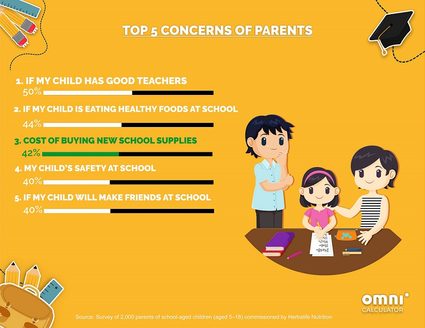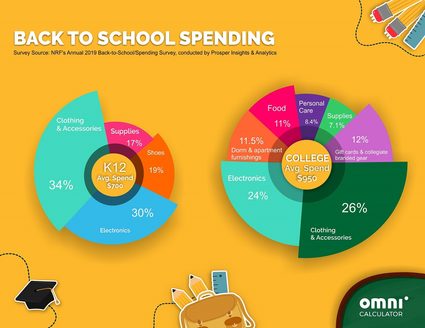Back to School Calculator
Who doesn't love the summer months? In July and August, life is all about vacations, traveling, barbeques with your friends, and relaxing on the beach with perfectly cooled drinks in hand. Right?
Right. Unless you are the parent of a school-aged child.
For most parents, summertime equals back-to-school season. If you have a school-aged child, surely you have wondered: "How will my baby do on their first day? How will they deal with waking up early and doing homework? And, most pressing of all, we just came back from our summer retreat - how on Earth will we pay for all these school supplies?"
Fortunately, dear parents, you are not alone! We have prepared this back to school calculator to ease at least some of these worries. With our help, you can set up an back-to-school budget (broken down piece by piece so you can stick to it), learn how to save money on school supplies and find out how to deal with the stress both you and your children are facing.

Back-to-school stress in numbers
According to , 70% of school-aged children's parents in the US find back-to-school shopping stressful. In an , OnePoll reports that for 57% of parents it is , in fact, the most stressful time of the year.
There is a number of factors at work here, from worries about the child's performance, health, and psychological well-being, to questioning the competencies of newly hired teachers. Money needed to provide children with the required school supplies is one of the most significant concerns, placing third at OnePoll's list of the biggest stress factors reported by parents.

The #1 money saving tip - plan a back to school budget!
We established that back-to-school season is hard on everybody. Now, a question remains - how to deal with the pressure it creates? We propose that you do something that will help you save money on the shopping and, at the same time, reduce the related stress by heaps.
What you need to do is to set up a budget! We believe that with the help of our calculator, you will be able to plan your spendings as precisely as possible, saving you a lot of time and granting you a little peace of mind in this tiring period.
Here are some tips on how to successfully plan your back-to-school budget:
-
Get a supply list. With the abundance of subjects taught at schools and the varying requirements set by the teachers, it's easy to get confused about what supplies are actually needed. Generally, it's a good idea to start your planning from looking up your child's school's website - most of them offer lists of supplies which cover the basics needed by the students throughout the school year. You might find help even on "higher" levels - for example, the official website of District of Columbia Public Schools has a divided into specific years. If all else fails, look up some example school supply lists on the web.
-
Divide the items you need into categories. That's the way we do it in our calculator - it really helps! Create sublists covering broader categories such as general supplies, clothing, electronics, etc. You will most likely buy these things in different places, so this might also be helpful in planning the actual shopping trip.
-
Check the prices before going to the store. We are lucky enough to live in an age when most stores have their complete stock listed on-line. Once you have a supply list ready, take some time to browse through on-line stores and producers' websites to orient yourself to the current prices. Compare the costs between stores and check if it makes sense to go to a physical store at all. More often than not, buying on-line pays off more. Remember to take shipping costs into account while considering this option. Although, if you'd need to drive a lot, you might want to compare the delivery fees with the results from the fuel cost calculator.
-
Create a precise plan of the shopping day. Once you decide which stores you want to visit, set up an optimal travel route between them. It's also a good idea to plan how much time you want to spend in each store exactly, as such limitations might help you avoid impulsive purchases.
-
Use our calculator to keep track of your expenses! You will find more detailed instructions on using the back to school calculator in the paragraph below.
If you're still unsure how much of your budget you should allocate to each category, you may find this infographic based on conducted by the National Research Federation helpful.

How to use the back to school calculator?
We want to make sure that your back-school-shopping is as stress-free as possible. That's why we also made sure that the back to school calculator is simple and intuitive to use. Just follow this set of instructions and you'll be enjoying the savings you will make as a result in no time!
1. Start by choosing the type of school your child attends (k-12 education or college).
2. Move on to the planned spending. Here, you have two options:
-
If you know exactly how much you are planning to spend, choose custom and fill the following boxes (total budget and specific categories) accordingly to your plan.
-
If you're not sure about your budget, select average. You will be presented with the back-to-school budget of the average American parent (based on the data provided by the NRF - if you want to read more on the subject, check out their articles on spending during the and back-to-school seasons). You can adjust the proposed amounts to suit your needs.
-
You will notice that the categories vary depending on the type of school you choose. The needs of k-12 and college students are drastically different - once your child starts college, they will need things like dorm furnishings, but more "classic" supplies, like crayons and scissors, are generally not needed anymore (although we don't judge). You will also see the most common categories with some example items. Remember, however, that these are only suggestions and feel free to change them to suit your needs.
-
NOTE: We add an additional 10% to the average budget to account for any unexpected expenses. We recommend you to do the same if you opt for a custom budget. You may find the percentage calculator handy here.
3. All that's left to do is to input the items you buy and their prices into our calculator. The tool will sum them up and let you know if you're in danger of exceeding your budget.
Can I really save on back-to-school shopping?
Short answer - absolutely!
Long answer - yes - if you're willing to take a little time to plan it out.
School supplies are not cheap, but there's a lot of additional measures you can take to cut down on expenses. The budgeting strategy we propose in our calculator is just the tip of the iceberg when it comes to smart hacks that you can use to minimize the cost of sending your kid back to school this fall.
"How can I save on my child's school supplies?" you ask? Here are some ideas:
-
Take stock of what you already have. This is absolutely crucial. lists buying stuff you already have lying around the house as the biggest mistake parents make in the back-to-school season. This year make sure to snoop around your house thoroughly - you are very likely to find unused notebooks, unfinished pencils, or a forgotten backpack that's in good shape. If your child's school requires uniforms, don't rush to the store for a new one. See if last year's uniform still fits and, should it need repairing, try to do it on your own first.
-
Consider donating to your school - you might get a tax deduction! Directly connected to the point above – if you have last year's supplies lying around, but your kid won't be able to use them (for example they are moving on from middle to high school and this year's needs are different), you can still utilize them and save some money. Because non-profit schools are considered charitable organization, the IRS allows you to make tax deductions on the things you donate to them. For more details, refer to Publication 526, Charitable Contributions, . Make sure to check whether this is available in your area!
-
Don't be wary of newsletters. We understand that getting a ton of spam from every possible store might get very annoying very quickly. During the back-to-school season, though, it may be worth it to suffer through it for a few days. Many stores send out newsletters with detailed lists of discounted items and, more importantly, offers that are exclusive to signed-up users. You might stumble on deals you would not otherwise get. After the back-to-school frenzy is over, you can easily unsubscribe from the newsletters and enjoy your spam-free mailbox once again. To check if a discount is truly worthwhile, you can use our discount calculator.
-
Time to get into coupons! Of course, we're not talking about extreme levels of couponing. Still, the fact remains that you can save a lot thanks to the coupons offered by many Sunday newspapers. During the back-to-school season, they are often focused on school supplies.
-
Buy early! Unfortunately, many stores use the back-to-school season as an opportunity to raise prices instead of lowering them. Just put a big red SALE sign on top of the shelf, and no one will look at the numbers, right? To avoid this, consider doing your back-to-school shopping as early as June - most stores begin their "sales" around mid-July.
-
...or buy late. Especially if you have some spare supplies from last year, it may be a good idea to postpone the shopping. Just make sure your child has the basics to use for the first few days - they will survive a week or two without a new set of colored pencils. Around mid-September, stores begin their end-of-season clearance sales. You will see the same items as during the back-to-school sales, but there is a good chance the prices will be much, much lower. Plus, you will avoid the crowds of panicking parents - there's nothing like serene shopping.
-
Don't take the kids to the store with you. Yes, really. Kids don't look at prices. What's more, they are very susceptible to marketing tricks such as bright colors, collectibles, etc. Store owners know this very well, and they don't hesitate to use that knowledge to draw kids in during the back-to-school sales. If you go alone, you are much less likely to overbuy stuff your child won't need. If you can afford brand names and whatever-franchise-your-child-is-into-themed supplies, you can ask them what they want and get it for them.
In all this frenzy, let's not forget about the children!
If the back-school season is stressful for the parents, imagine how the children must feel! While their worries are different, their concerns are still valid. Children nowadays have a lot on their plates - the ever-growing amount of schoolwork, keeping up with the newest trends, avoiding bullies, fitting in with their peers, and fatigue caused by not sleeping enough, life is, unfortunately, stressful for kids.
The offers advice on helping your child deal with the pressure that comes with the end of summer. APA stresses the importance of communication on the parent-child front. Make sure you talk about your child's worries - they need to know that they can come to you with any trouble they face at school! It is also advised to practice the school routine in advance - try to get your child to start going to bed early as soon as August, so they have enough time to get used to waking up in time for school. The sleep calculator can help you make it as painless as possible and ensure that your child wakes up refreshed.
